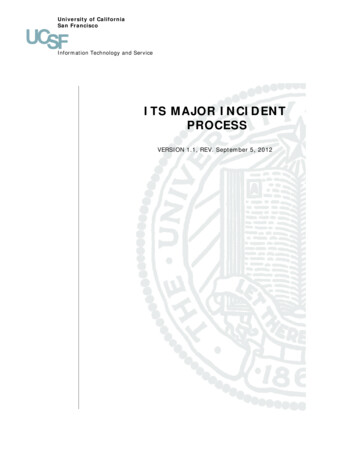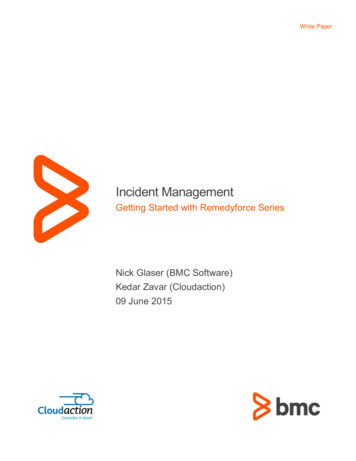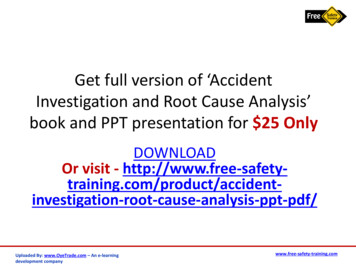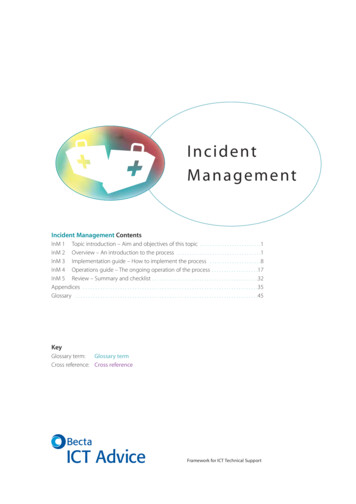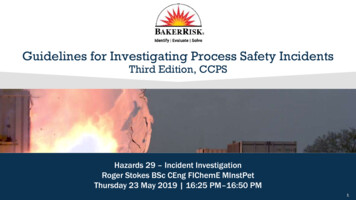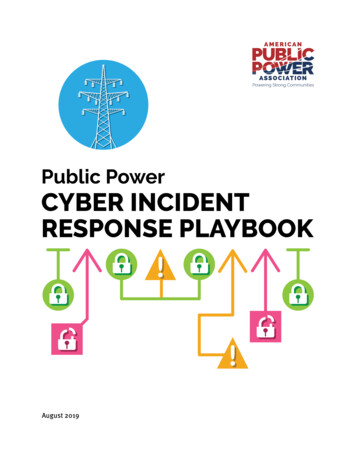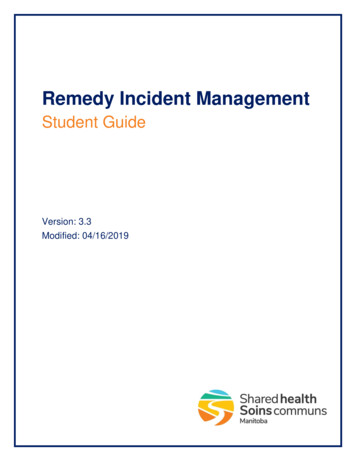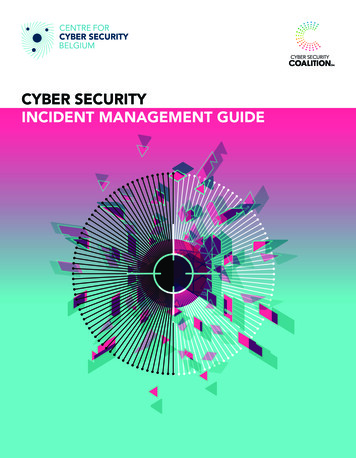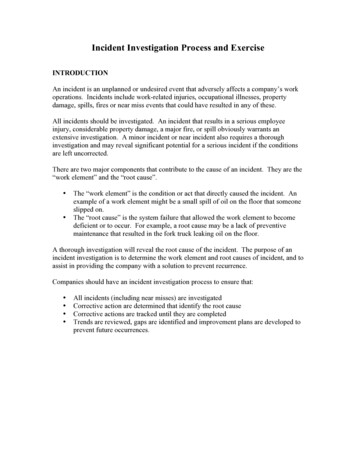
Transcription
Incident Investigation Process and ExerciseINTRODUCTIONAn incident is an unplanned or undesired event that adversely affects a company’s workoperations. Incidents include work-related injuries, occupational illnesses, propertydamage, spills, fires or near miss events that could have resulted in any of these.All incidents should be investigated. An incident that results in a serious employeeinjury, considerable property damage, a major fire, or spill obviously warrants anextensive investigation. A minor incident or near incident also requires a thoroughinvestigation and may reveal significant potential for a serious incident if the conditionsare left uncorrected.There are two major components that contribute to the cause of an incident. They are the“work element” and the “root cause”. The “work element” is the condition or act that directly caused the incident. Anexample of a work element might be a small spill of oil on the floor that someoneslipped on.The “root cause” is the system failure that allowed the work element to becomedeficient or to occur. For example, a root cause may be a lack of preventivemaintenance that resulted in the fork truck leaking oil on the floor.A thorough investigation will reveal the root cause of the incident. The purpose of anincident investigation is to determine the work element and root causes of incident, and toassist in providing the company with a solution to prevent recurrence.Companies should have an incident investigation process to ensure that: All incidents (including near misses) are investigatedCorrective action are determined that identify the root causeCorrective actions are tracked until they are completedTrends are reviewed, gaps are identified and improvement plans are developed toprevent future occurrences.
INVESTIGATION PROCESSProper training and a clear understanding of roles and responsibilities is essential to theinvestigation process. All employees and people that will be involved in an incidentinvestigation should be aware of what their role is in the process and how to perform theirassigned responsibilities during an investigation process.Employees: Report all work-related incidents in a timely manner Participate in the investigation process, as neededSupervision/Management: If the incident was very recent, secure the scene of the incident to ensurethe safety of any emergency responders and other employees, and topreserve any evidence that may contribute to the investigation Ensure the injured person is properly cared for Ensure management or other company personnel who require it arenotified. OSHA or another government agency may also be required to benotified, depending on the type and/or severity of an incident. (Forexample, in OSHA 1904, recordkeeping requirements require that anyfatality, or any hospitalization of 3 or more persons because of a workrelated incident be reported to OSHA within 8 hours of the incident.) Ensure the investigation begins as soon as possible after the incidentoccurs Identify the potential sources of information, such as the injured person,witnesses and any physical evidence Gather the facts about the incident Ensure the investigation identifies the root cause Make and/or implement recommendations to control or eliminate thehazard Ensure all regulatory and company requirements are met (OSHArecordkeeping, notification, written reports, insurance claims, etc.) Perform any trend analyses of past incidents that may identify additionalhazard prevention methods (i.e. training, maintenance, procedures, etc.)The ultimate responsibility for an incident investigation rests with management.Supervisors must take charge of a thorough incident investigation. Depending upon thetype and scope of an incident (i.e. major spill or fire, or several employees injured in oneincident), a team approach to the investigation of the incident may identify additionalcorrective actions that will help prevent similar incidents in the future.Investigations must be constructive, credible and timely. Remember that the investigatoris trying to figure out what happened and how to prevent similar situations, not trying toplace blame on any individual or group. If the investigation is antagonistic, and takes a“what did you do wrong?” approach, then the process becomes much more difficult, asemployees do not want to be blamed or cooperate in a blame-giving situation. A more
constructive approach is “what happened, and what can we do to prevent this fromhappening again?”Timing of an incident investigation could be crucial to the outcome. If an employeereports an incident that happened three weeks ago, all an investigator has to go on is whatcan be remembered by the persons involved. People’s memories fade or evidence maybe disturbed which could hamper the investigation process. With timely reporting, aninvestigation can take significantly less time to complete, and operations will be able toresume more quickly.GATHER EVIDENCEOne of the most critical and complex parts of the investigation is the gathering ofevidence. There are some basic rules that may help the process.Interviewing involved employees: Put the individual at ease – make sure they know the primary purpose ofthe interview is to prevent a recurrence of the incident and that it can onlybe done with their help. Avoid finger-pointing and applying blame.Treat people with tact and respect. Make them aware that they need to bethorough and truthful in their account of the incident and that you are notthere to get anyone into trouble, only to find out what happened and why,so that it won’t happen again. Be aware that injured employees and witnesses to injuries may have someemotions involved that affect them. Especially if the incident was severe,there may be some trauma that occurs. Stress fact gathering. Let involved employees tell their story completely.Wait until they have finished their version of events before interrupting orclarifying what was said. Then go over what they stated with them, toassure that you have their account of the story accurately and that youunderstand what they meant, not just what they said. Do not makeassumptions or state opinions during this process. If other people havesaid something different from what was stated in this interview, askleading questions to discover more information, but do not contradictwhat was stated in either interview. Conduct the interviews at the scene, if possible. This may help people toexplain and may help the interviewer understand what happened. Makethe interviews as private as possible, so that other employees cannot takeany offense or contradict what is said. Witnesses may be interviewed at alater time, if privacy is at issue. Ask any necessary questions to determine what happened, what was done,and how it was done. Try to avoid asking WHY questions that may makepeople defensive. Close the interview on a positive note. Discuss the actions taken, or thatwill be taken if you know them. That will reaffirm the purpose of the
interview. Make sure you thank the interviewee for their help in theinvestigation process.Use the right tools during the investigation process: Paper and pencil is the basic tool. Taking notes can jog a memory later onwhen you are writing any investigation or incident reports. Record times,places, names, distances, comments, conditions or anything else you maythink will help. Take pictures, if possible. A picture is worth a thousand words. Take anoverall picture first to keep an idea of where the incident took place. Thenget any close up shots of spilled material, machinery or equipment thatmay have been involved. If needed, place a ruler or other object that is ofa known size in the picture, so that you can more easily determine size orscale within the picture. Draw a sketch or diagram. This is useful especially when the incident iscomplex. Use the diagram to indicate where key objects or people wereduring the incident.DETERMINE THE ROOT CAUSEMany times it is easy to determine what the work element is that directly caused theincident. It could have been a flying chip, a spill on the floor, or lifting a load that wastoo heavy. However, discovering the system failure that allowed the deficient workelement to occur is sometimes more difficult. This system failure is also known as theroot cause. To make it easier to determine, root causes (in general) can be placed into sixdifferent categories.
Basic elements of root vironmentmethodsSome examples of each of these root cause elements are as follows:-MaterialsDefective raw material(s)Wrong type of material for jobNot enough raw material-EnvironmentOrderly workplaceJob design or layout of workSurfaces poorly maintainedPhysical demands of the taskOther conditions (noise, lighting, etc.)-MethodsNo or poor proceduresPractice does not mesh with writtenproceduresPoor communication-Machine/EquipmentIncorrect selection of tool or equipmentPoor equipment maintenance or designPoor equipment or tool placementDefective equipment or tool-ManNo or poor management involvementInattention to taskTask hazards not guarded properlyOther (horseplay, inattention, etc.)Stress demands-Management SystemTraining or education lackingPoor employee involvementPoor recognition of hazardPreviously identified hazards were noteliminated
DOCUMENT THE FINDINGSA well conducted investigation identifies the work element(s) that caused the incidentand helps to eliminate the root cause(s). After the investigation is completed, theinvestigator then begins to document the incident and their findings. The incidentdocumentation should contain specific elements. When the incident happened. Date and time may be crucial because of work loador shift change. Who or what was affected or hurt by the incident. If an employee was involved,or a piece of equipment damaged, be specific about which piece of equipment andthe extent of damage or injury. Where it happened. Again, specific details may be critical to the investigationanalysis or trends that may be present. What object, if any, caused the incident. What work element was deficient and most directly caused the incident. If therewas a specific condition (i.e. lifting, twisting, spills, poor maintenance, fallingobject, defective equipment, lack of procedure, poor lighting, etc.). What system failure (or root cause), if any, was evident that needs to be correctedthat will prevent a recurrence (i.e. lack of a maintenance schedule, lack oftraining, lack of procedures, etc.).FOLLOW UP AND ANALYZEOnce the documentation phase is complete, corrective actions should be implemented.Employees in the work area should be notified of any equipment, procedures oradditional training that has resulted from the investigation process. These correctiveactions should be followed up to assure they are effective, and that employees arefollowing any new processes.If more than one incident has occurred that may be related, management should reviewthese incidents and look for similarities that may need to be addressed. Individualincidents and near misses may show one or two items that need addressing, howeverwhen taken all together, there may be a greater issue that can address the overall problem.Frequently the answer to individual incidents is as simple as wearing/using protectiveequipment/guards or proper lifting procedures. But sometimes a manager needs to take astep back and look at a group of incidents that may be less obviously related. Alifting/lowering training program, or hand protection awareness program, a writtenprocedure for locking out all types of machinery prior to servicing, or a preventivemaintenance schedule for fork lift trucks, may address several needs at one time.
INCIDENT INVESTIGATION EXERCISEWork through this example scenario. It is designed to provide you with an understandingof the incident investigation process.Scenario: Joe is operating a conveyor system upon which product is placed after packingand prepping for shipment. His job is to make sure the conveyor is operating andcarries enough product so that fork truck drivers have a continual flow to filltrailers. He has a backup in the system and goes to investigate, and finds some shrinkwrap has wound around a gear on the conveyor. This causes the pallet to be offcenter, and a jam occurs. He pushes the pallet of boxes to release the jam (whilestanding on the edge of the conveyor). The jam is released, and several pallets ofproduct move and impact Joe. He subsequently falls off the conveyor.
Result: Joe suffers a contusion on his left temple from an upright post, scrapes his leftknee and wrenches his back. He is currently out of work. Time 3:00 PM (shift ends at 4:30 PM) Temporary employee that works with Joe was not in that day.Investigation: There are three employees who work in the department and were present at thetime of the incident:– 1: ‘He was stressed because several trucks were waiting for product’– 2: ’Jams happen a lot there, something always catches, but maintenancecannot seem to find anything’– 3: ‘I have seen Joe clear jams like that before’ Joe’s supervisor, the warehouse manager: ‘Maintenance has made a tool to pushjams out so that employees do not have to climb on the conveyor, apparently Joedid not use it.’Cause Determination:manJoe fellmaterialBoxes lurchedOn top systemLow staffingTemp outrushingenvironmentincident
Cause Determination (Fault Tree):Pushingtool?Push productOn top of conveyorProduct dislodgedProductjamJoe fellFinal Analysis: Basic Causes:– Improper Design, Maintenance, Enforcement of Tool Use, Lack of Help; Indirect Causes (Intermediate Causes):– Climbing on Conveyor; Rushing; Direct Causes:– Boxes Lurched; Result– Fell and was injured; Root Cause is Basic - Management or Design;Injury
The ultimate responsibility for an incident investigation rests with management. Supervisors must take charge of a thorough incident investigation. Depending upon the type and scope of an incident (i.e. major spill or fire, or several employees injured in one incident), a team approach to

